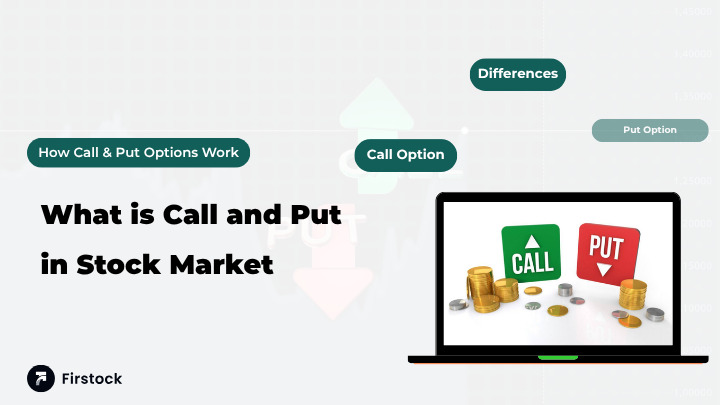Difference Between Call Option and Put Option | Simple Guide
November 14, 2025 | by IoT Development Company

Difference Between Call Option and Put Option: A Complete Beginner-Friendly Guide
If you’re new to the stock market and keep hearing terms like call option, put option, or options trading, you might be wondering—What do these even mean? Don’t worry. You’re not alone. Options may seem complicated, but once you break them down, they’re much easier to understand.
Think of call and put options like two different types of “tickets” that let you make strategic moves in the market—sometimes even without owning the actual stock. This article explains the difference between call option and put option in the simplest way possible, using examples, analogies, FAQs, and beginner-friendly explanations.
Before we begin, here’s a structured Table of Contents to help you navigate through the article.
Learn what is call and put, difference between call option and put option, call and put options examples, call option and put option basics, and tips for trading apps for beginners.
Introduction to Options Trading
Options trading can look like a puzzle, especially when you’re just starting. But once you understand the basic concepts—what is call and put—everything begins to make sense. Think of this as the foundation of a building: once you get it right, the rest becomes easy.
Options give you flexibility, control, and the ability to profit in rising or falling markets. But most importantly, they let you manage risk in a smarter way.
What Is Call and Put? (Simple Explanation)
Let’s break this down in the simplest terms:
- A Call Option gives you the right to buy something at a fixed price.
- A Put Option gives you the right to sell something at a fixed price.
You’re not forced to buy or sell—you simply have the option.
Think of options like reservation tokens.
Imagine reserving a dinner table at your favorite restaurant. You’re not forced to eat there, but you have a guaranteed spot if you choose to go. A call or put option works just like that—you’re reserving a price.
Understanding What a Call Option Is
A call option gives you the right to buy a stock at a fixed price known as the strike price before the expiry date.
When do people buy call options?
People buy call options when they believe:
- The price of a stock will go up soon.
- They want leverage (control more shares with less money).
- They want to lock in a good price before the market moves.
Understanding What a Put Option Is
A put option gives you the right to sell a stock at a fixed price.
When do people buy put options?
People buy put options when they believe:
- The price of a stock will fall soon.
- They want to protect their portfolio (hedging).
- They want to earn profit from market downturns.
Key Difference Between Call Option and Put Option
Here’s the simplest comparison:
| Feature | Call Option | Put Option |
| Meaning | Right to buy | Right to sell |
| Used When | Expect price to rise | Expect price to fall |
| Buyer Profit | When stock price goes above strike price | When stock price goes below strike price |
| Seller Risk | Higher if price rises | Higher if price falls |
Call and Put Options Examples (Real-Life Scenarios)
Let’s look at relatable examples so the concept becomes crystal clear.
Example of a Call Option
You buy a call option for Stock A at a strike price of ₹100.
- If Stock A rises to ₹150 → You profit.
- If Stock A stays below ₹100 → You lose only the premium.
Example of a Put Option
You buy a put option for Stock B at a strike price of ₹200.
- If Stock B falls to ₹150 → You profit.
- If Stock B stays above ₹200 → You lose the premium.
Why Do People Trade Options?
Options offer benefits like:
- Lower investment cost
- Higher potential returns
- Flexibility in bullish or bearish markets
- Risk management
- Hedging strategies
It’s like having tools for every type of weather—sunny or stormy.
How Call and Put Options Work in Profit and Loss
Call Option Profit
When stock price > strike price.
Put Option Profit
When stock price < strike price.
Your Loss?
Loss is limited to the premium you pay—nothing more.
This is why beginners often prefer options over buying or selling stocks directly.
Strike Price, Premium & Expiry (Explained Simply)
Let’s simplify this:
- Strike Price → Pre-decided price at which you can buy/sell.
- Premium → The cost you pay to buy the option.
- Expiry Date → The last day your option is valid.
Think of it like booking a movie ticket:
- Strike price = seat price
- Premium = booking fee
- Expiry = movie showtime
If you don’t go, you lose the booking fee but nothing else.
Call Option Strategies for Beginners
Here are the simplest call strategies:
• Long Call
Buy a call → Expect price rise.
Risk: Limited
Reward: Unlimited
• Covered Call
Own stock + sell call option
Great for conservative investors earning steady income.
Put Option Strategies for Beginners
• Long Put
Buy a put → Expect price drop.
Risk: Limited
Reward: High
• Protective Put
Own stock + buy put option
Acts like insurance for your portfolio.
Risks in Call and Put Options
Options have risks too:
- Time decay (value decreases near expiry)
- Wrong prediction of price movement
- High volatility
But compared to traditional trading, your maximum loss is usually limited.
Choosing Trading Apps for Beginners
If you’re new, choose trading apps for beginners that offer:
- Simple user interface
- Live charts
- Learning resources
- Quick support
- Options analytics
- Low fees
Good trading apps can make your journey much smoother.
Common Myths About Call and Put Options
Myth 1: Options are only for experts
Fact: Beginners can use simple strategies safely.
Myth 2: Options are extremely risky
Fact: Risk is limited if you buy options.
Myth 3: You need lots of money
Fact: Options require less capital than buying shares.
Conclusion
Understanding the difference between call option and put option is the first major step toward smart options trading. Whether markets go up or down, call and put options give you powerful tools to manage risk, profit, and participate in market moves confidently.
Remember: start small, learn continuously, and use reliable trading apps for beginners to practice safely.
FAQs
1. What is call and put in simple words?
A call option gives the right to buy; a put option gives the right to sell at a fixed price.
2. What is the main difference between call option and put option?
Call = buy. Put = sell. Calls profit when prices rise; puts profit when prices fall.
3. Can beginners trade call and put options?
Yes! With the right guidance and good trading apps, beginners can start with basic strategies safely.
4. Are call and put options risky?
Buying options has limited risk (only the premium). Selling options has higher risk.
5. What are some call and put options examples?
Call example: Buy right to purchase a stock at lower price.
Put example: Buy right to sell stock at higher price.
RELATED POSTS
View all



